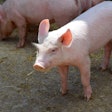
African swine fever (ASF) virus continues to be detected in large numbers of backyard herds in Bosnia-Herzegovina and Croatia, while large commercial farms have been hit by the disease recently in Romania and western Russia. Among wild boar, new cases have been confirmed in 12 European countries.
Among their respective populations of domestic pigs, Balkans nations continue to register new outbreaks of ASF.
Over the past week, a further 320 farm outbreaks have been officially reported by the Croatian veterinary authority. According to its latest notifications to the World Organisation for Animal Health (WOAH), these directly impacted 6,145 swine.
All these outbreaks occurred in Vukovar-Srijem, a county in the northeast of the country where almost all of the recent cases have been detected. It also borders Serbia and Bosnia-Herzegovina, where ASF is also circulating.
Since Croatia’s first cases were confirmed at the end of June, 801 ASF outbreaks affecting almost 16,000 pigs have been reported to WOAH. Also testing positive for the ASF virus have been seven of the nation’s wild boar. These were found in Vukovar-Srijem, as well Sisak-Moslavina and Karlovac, which are adjacent counties to the west.
More than 17,000 pigs have been culled in the country as a result of ASF, reported Total Croatia News on September 28. Amounting to around 2% of the national pig population, this figure includes infected animals as well as those at risk of infection.
Spread of the disease has caused turmoil for pig farmers, local administrations, and the government, according to the report. An official at the Croatian Chamber of Agriculture criticized a range of stakeholders for a lack of prompt and effective action to control the disease.
For local people, the most obvious features were police-patrolled checkpoints on the border between Vukovar-Srijem and neighboring Osijek-Baranja. This latter county is the center of Croatian pig production.
According to the State Secretary for Agriculture, control measures have been carried out according to international guidelines, and in a timely manner.
Figures reported by this source put the financial support given or committed for almost 800 people affected by ASF at more than EUR4.1 million (US$4.34 million).
There are signs that the increase in new cases is now slowing down, said the head of the virology at the national veterinary institute, who expects this trend to continue.
Pork is the most consumed meat in Croatia, according to this source. With ASF causing mortality and culling of local pigs at the same time as European production is contracting, this source fears pig meat prices will rise sharply for Croatians in the coming months.
ASF in domestic pigs elsewhere in Europe
Recording the most new outbreaks over the period September 21-27 was Bosnia-Herzegovina, with 210. This is according to the latest weekly update of the Animal Disease Information System of the European Commission (EC). It covers the European Union (EU) member states and immediate neighbors. This source also records 54 additional outbreaks in Serbia, and one in Kosovo.
Also located on the Balkan peninsula in southeastern Europe are Romania and North Macedonia. Over the past week, the animal health agencies of these two countries have registered with WOAH 18 and five new ASF outbreaks in domestic pigs, respectively.
While all the outbreaks in North Macedonia were at premises described as “backyards,” three commercial farms were affected in southeastern Romania. With around 18,700 pigs, the largest of these was in the county of Calarasi. The other two were located in Braila, and each had a herd of around 1,600 animals.
At the end of September, the ASF virus was detected at a farm in Russia’s North Caucasian federal district.
According to the WOAH notification, the premises in Krasnodar krai had just over 8,000 pigs, two of which died. This was the fifth outbreak in this area over the previous four weeks.
In northern Ukraine, ASF outbreaks have recently affected a farm with around 450 pigs in Chernihiv, and a single pig kept in the Kyiv area.
Meanwhile, Poland’s total outbreaks in domestic swine in 2023 has risen by two to 27.
Latest to be affected were small herds in the northwestern province of West Pomerania, and in adjacent Greater Poland, according to the chief veterinary office.
In Italy, the national reference laboratory for ASF IZSUM reports that the virus has been detected at a ninth farm in the Lombardy region.
Starting at the end of September, this appears to have affected a breeding farm although the number of animals affected is not given.
Previous investigations prior to the movement of weaners to another premises revealed no signs of disease. Samples were taken four days previously, and clinical examinations were carried out two days before some pigs died suddenly. Subsequent ASF tests on these animals were positive.
Further cases reported in wild boar
Over the September 21-27 period, 11 European states registered new cases of ASF in their respective wild boar populations through the EC’s System. These were Croatia, Germany, Hungary, Italy, Latvia, Lithuania, North Macedonia, Poland, Romania, Slovakia and Sweden.
Numbers of additional outbreaks were generally fewer than 10, except for Poland (30 new outbreaks) and Lithuania (14).
Latest update from the state veterinary institute SVA puts Sweden’s total confirmed cases of ASF in wild boar at 49.
Since the country’s first case at the end of August, all infected animals have been found in the core area around the town of Fagersta in Västmanland.
In the same report, SVA confirmed that the recent death of a domestic pig in the neighboring county of Östergötland was not due to ASF.
The EC does not monitor the disease situation in Russia. However, the veterinary authority has notified WOAH about three further cases of ASF in wild boar in Nizhny Novgorod. These bring to six the number of infected animals detected in this region of the Volga federal district since May.
View our continuing coverage of the global African swine fever situation.

















